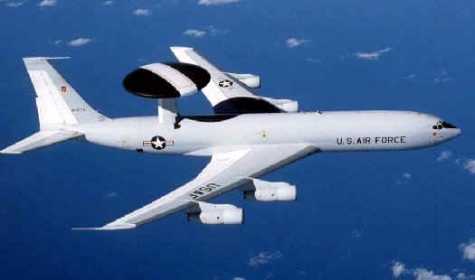
The E-3 Sentry Airborne Warning & Control System

The E-3 Sentry Airborne Warning & Control System
If you ask the DEA what percentage of smuggled drugs they intercept, they'll give you exactly the same answer they gave in 1928 or 1948, "about 10%", which is both a wild exaggeration and a cover story. A busy port receives over 100,000 containers a week. They can't even search 1%, let alone nail 10%. A DEA official in "candid" mode will admit they really intercept only 5%, still an absurd exaggeration, although the confiscation laws do enable the narks to make make money coming and going. They're just part of the system.
A wild peninsular coastline like Washington State-British Columbia is uncontrollable. NYT:1/31/95: "Canada has only a few Coast Guard cutters and Mountie patrol boats to watch 16,900 miles of [BC] coastline." The U.S. has almost 90,000 miles of coastline, 300 ports of entry.
As of early 1998, the U.S. had 7,000 agents patrolling the sexy 2,000-mile Mexican border, but only 300 covering the entire 5,500-mile Alaska-Canada-U.S. border. 99% of Canada's superb hydroponic pot gets through, making it a multi-billion dollar factor in the Canadian economy.
Otay Mesa, next to Tijuana, is the main commercial truck entrance from Mexico's maquilladora ("final touch") factories into the U.S. It is overwhelmed with traffic, 24/7. "Spend a couple of hours at Otay Mesa, and you'll notice a lot of guys on either side of the border just hanging around, chatting a lot of the time on their cell phones. They're spotters for trucks on drugs runs. They tip off the driver about what time to come, which lane to use, what to say, and the DEA can't tap into their calls because they all have encryption or scrambler devices." That is, they're coordinating the drug run with their very own customs agents, who make as much as $50,000 in untraceable street cash simply for waving a hot truck through. That's a year's wages for ten minutes work.
U.S. Customs mapped 500 airstrips within a hundred miles of either side of the Mexican border. Of nearly 7,000 suspicious flights detected by the Pentagon in 1990, 49 were caught. In 1996, The Christian Science Monitor informs us, "AWACS provided information that led to four cocaine interdictions worth $945 million - about 35 percent of all cocaine intercepted coming into the US." That is, about Ļ of 1% of all the cocaine coming into the U.S.
CSM:"'Interdiction, although it is often bad-mouthed, has to be one of the principal components of the fight against drugs,' says a retired military officer who now serves in the president's Office of National Drug Control Policy. 'The capstone is the AWACS with their special "look down" radar. Nothing gets by them when they are up.' As it turns out, the green blip - signifying a small airplane flying low over the ocean, southeast of Florida - was not trafficking in illegal drugs." That is, the celestial AWACS has no earthly way of distinguishing between the scores of small aircraft on its screen at any one time. That means that one scramble in 100 hits the mark.
Thanks to the political pressure, coke and pot seizures were up along the Mexican border in 1995. The Nogales Border patrol station seized a little more than a ton of coke in 95. But that's just a 1% tax to smugglers who can slip more than a hundred tons through Nogales each year. But Mexican streetfighters don't take that Gringo crap nohow. Phil Jordan, 1995 DEA director of the El Paso Intelligence Center, had his brother shot dead in an El Paso street by a Mexican hit squad. And they're not above hitting his kids, either. This gives Jordan's subordinates serious pause when offered a piece of the action by a Mexican hit team. "It's kind of like this," explains Robert Nieves, former DEA Chief of International Operations, "You're offered a bribe. If bribery doesn't work, you're offered violence. And that violence will be exacted against you or your family members." Plata o Plomo, Silver or Lead, as the famous phrase goes.

Jorge Hank Rhon and Customs Port Director Jerry B. Martin
Still, one still wonders why the border continues to be so porous, given the muscle the El Paso Intelligence Center, operating along with Army Joint Task Force 6 out of Biggs Army Airfield, can muster. Biggs employs some 300 people coordinating intelligence from all Pentagon, NSA, FBI, Treasury, DIA and CIA sources, and can mobilize military SWAT teams. Senior Customs Inspector John Carman provides part of the answer:„Millionaire-Smuggler-Crime Figure Jorge Hank-Rhon and Customs Port Director Jerry B. Martin. Both associated with former District Director Allan J.Rappoport and John „Jackš Maryon, who were all under investigation, but Customs Internal Affairs, FBI, or the other Federal agencies investigating did nothing about these dangerous liaisons... I was őordered‚ not to put Jorge Hank Rhon‚s name into the Customs/Treasury look out system TECS (Treasury Enforcement Computer System) because of another Customs Supervisor named John „Jackš Maryon. Hank Rhon was later caught smuggling more currency at LAX international airport.š www.customscorruption.com
The above-quoted DEA Chief of International Operations, Robert Nieves, before rising to that exalted position, ran the DEA‚s Costa Rica office. He ran interference for the Contras and Manuel Noriega against the likes of reformist antidrug revolutionary Hugo Spadafora and reformist antidrug DEA agent Celerino Castillo. It was Nieves who protected Hank Rhon‚s trading partner Norwin Meneses for the CIA, literally helping to run his huge Contra-cocaine supply operation, as Gary Webb has documented in such detail. Nieves then went on to head the DEA‚s cocaine task force in DC - with zero strategic effect, needless to say. After his 1995 retirement, Nieves went to work for body armor manufacturer Guardian Technologies - owned by Oliver North and Contra-era Costa Rica CIA station chief Joe Fernandez, both barred from Costa Rica for dealing in multiton loads of cocaine. With leadership like that, the pipeline is open.
The rest of the answer to the open border question, aside from John Carman's computer-entry orders, is that their TECS, NADDIS and NIN (Narcotics Information Network) computer system is just another impotent eye in the sky. It don't tell them squat about the cucarachas. NADDIS can go after money-laundering "kingpins" all it wants. But it's the system - the bottom-up economics of street-dealing - that generates the "kingpin," not the other way around.
As Clinton deplaned in Mexico on 5/5/97, I heard reporters on all three major networks authoritatively declare that the Mexican drug problem was really "kingpin" Amado Carillo. That's just the fluff of the moment, the dehydrated, homogenized formula - just add air time and whip. The reportage on all three networks was virtually identical, word for word, as if these guys were reading press releases. Not one reporter mentioned the economics of Prohibition, although one did add some parenthetical mumbling about "corruption."
The DEA guesses that more than 500 tons of coke were successfully smuggled into the U.S. in 1996. Their guess, and they admit it's a guess, is probably a gross underestimation, given that total coke siezures, including all maritime seizures, were close to 80 tons. But even according to the DEA's own figures, so much coke gets through that confiscations, however heavy, simply function to protect the value of the successfully smuggled imports.
To quote the State Department's own end-of-year 1996 Enforcement Affairs report, "in FY 1996 the total USG budget for international drug control operations was approximately $1.6 billion. That equates to 16 metric tons of cocaine; the drug trade has lost that much in two shipments and scarcely felt the loss."
The General Accounting Office, in 1997, reported that all interdiction and seizure efforts made by the U.S. Government between 1988 and 1995 "made little impact on the availability of illegal drugs in the United States and on the amount needed to satisfy U.S. demand."
That is, drug enforcement throughout the U.S. simply has the practical effect of protecting, indeed creating, the artificially inflated street value of illegal drugs, thereby financing the smugglers. That's the fascist game. That's why Santos Trafficante, a genius at smuggling contraband, worked for the CIA. Trafficante, of course, was also a genius at keeping himself relatively unknown.
We are constantly told that the death of a "kingpin" is a strategic victory, but it's the system that generates the dealer, not the dealer the system. J. Edgar Hoover pioneered the well-publicized destruction of "kingpins," brilliantly throwing a blanket of PR over his ineffectiveness and corruption. Hoover used the same ghost writer as Harry Anslinger, former circus press agent Courtney Ryley Cooper, the man who invented the phrase "Reefer Madness." Cooper wrote flashy magazine stories dramatizing J. Edgar's fictitious personal encounters with "America's most wanted."
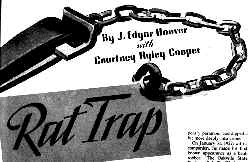
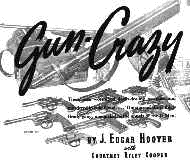
In 1939 Hoover decided that Lepke Buchalter was "the most dangerous man in America." This momentous decision was forced on J. Edgar when Lepke got himself indicted in 1937 for importing huge amounts of Japanese-KMT heroin from Tientsin. Although the FBI had nothing to do with the investigation or the indictment, it asked Lepke's partners, Lansky and Luciano, to hand him over to Hoover personally, in the presence of Walter Winchell, no less, in exchange for anonymity and protection. Lansky and Luciano wisely complied - it was good for business, and they were wise guys.
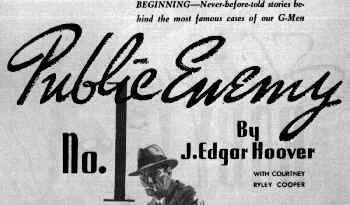
Trafficante, Marcello, Giancana, Rosselli, Lansky, Costello, Dalitz, Licavoli, Dragna, even the flamboyant Luciano never became FBI "Public Enemies" like John Dillinger or Pretty Boy Floyd, redneck pistoleros who never actually owned a Banana Republic. Of course, if Hoover's objective wasn't the suppression of organized crime but the suppression of political dissent, then he was, by his lights, acting correctly. Lansky, left, was a dedicated "anti-communist." Look how he helped Lepke "decommunize" the New York clothing industry. Look how Joe Adonis, right, helped clean the Reds out of Sicily, and Guatemala. Look what Trafficante did for Cuba. Hoover's FBI never went after the Syndicate or narcotics at all.
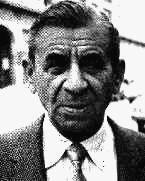

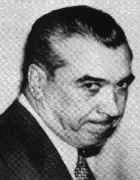
I remember seeing roving U.S. ambassador Lewis Tambs, in a PBS Frontline documentary on Medellín "kingpin" Pablo Escobar, at pains to stress J. Edgar's old line. He said the drug business is "dealer-driven," and that if we'd only concentrate on these nasty people, we could ignore all that fussy structural stuff. Bullshit. Escobar's dead and Colombian coke is flying through the pipeline faster than ever. Cali "kingpins" are biting the dust too, but Colombian coke just keeps on flowing through La Pipa.
The State Department's end-of-year 1996 Narcotics Control Strategy Report also goes on and on, country by country, about the destruction of "kingpins," continually claiming completely imaginary strategic progress. It measures this progress not only by the death of this or that bad guy, literally counting bodies, but by its successful efforts to enhance "police-military cooperation" in-country with U.S. enforcement entities. "Progress," of course, justifies an ever-expanding budget. It also points to the real import of the Drug War - the enhancement of U.S. power "in-country."
On May 2, 1996, Attorney General Reno, flanked by a phalanx of heavies, treated us to her John Mitchell impersonation. She announced that the United States had smashed a major drug ring with "tentacles" extending into Colombia, Mexico and cities all across the U.S. The operation netted 130 arrests, $17 million in cash and 6 tons of cocaine. "The most sophisticated and the most well-coordinated effort that I've ever seen," beamed one DEA official, who surely must have known better. The bust was trumpeted, in a strangely homogenized way, all over the media as a tactical victory in the War. The fact that busts like this have been routine for the past 25 years, and that the Colombians replaced the coke and the street dealers within ten minutes, wasn't mentioned. All Reno actually did was reinforce the value of the mountain of coke that remained on the street, thus creating yet more incentive to produce more coke as rapidly as possible.
The Colombians distribute much of their coke through the Gangster Disciples, who are so powerful they can buy 300-kilo lots direct and manage the nationwide distribution themselves. That's not just a gang, that's a culture. The Disciples can use their army of wholesalers to front ambitious 12-year-olds a "sixty-pack" of ten-dollar crack vials. An outgoing hustler can sell-out in half an hour. The kid keeps a hundred, turns $500 over to the wholesaler, and gets another sixty-pack. The kid can make $1000 in a day, and the wholesaler many times that. The cops end up at war with the whole neighborhood.
"Gang violence has spread to every corner of America," intoned Janet Reno, as she announced the results of the July, 1996 survey of gang activity, which showed an estimated 650,000 gang members in 25,000 gangs nationwide. These figures demonstrate the need for yet more and better warfare aimed at the projects, insisted the AG.
Thanks to this logic, the Bloods, the Crips, the Vice Lords, the Cobra Stones and the Gangster Disciples have an ironclad monopoly on street dealing throughout the U.S. The power-hungry Disciples enforce their membership with savage rules of violence. You come to work on-time, and you come to work sober, or else. You don't screw up the brothers. These guys are more disciplined than the Mafia ever was. These serious pistoleros won't be dignified in the media as freedom fighters, of course, but they sure as hell are fighters, and many see themselves as freedom fighters. The Gangster Disciples call themselves "Brothers of the Struggle." Try taking the night away from them in downtown Chicago.
The Gangster Disciples, created in 1974 by an organizational genius named Larry "King" Hoover, from prison, now have 30,000 members in 35 states - and an annual income of at least $100 million. You better believe they know how to defend their turf. So what if King Hoover gets another 200 years added to his life sentence. How's that going to affect his Midwest pistoleros, or the cops on their payroll? If you were offered $10,000 for one night's work, or a bullet in the head, which would you take?